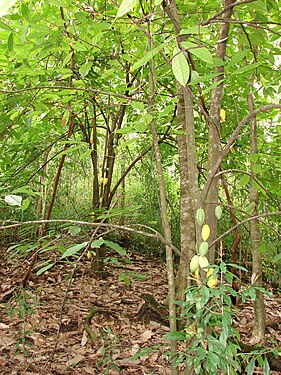Cacao
| Habit | tree
| |
|---|---|---|
| Height: | ⇕ | 25 ft"ft" can not be assigned to a declared number type with value 25. |
| Width: | ⇔ | 10 ft"ft" can not be assigned to a declared number type with value 10. |
| Lifespan: | ⌛ | perennial |
| Exposure: | ☼ | part-sun |
|---|---|---|
| Features: | ✓ | edible, fruit |
| USDA Zones: | 11 to 12 | |
| Flower features: | ❀ | red, pink |
|
cacao > |
L. > |
Theobroma cacao (Mayan: kakaw, Nahuatl: Cacahuatl), also cacao tree and cocoa tree, is a small (4–8 m or 15–26 ft tall) evergreen tree in the family Sterculiaceae (alternatively Malvaceae), native to the deep tropical region of the Americas. Its seeds are used to make cocoa powder and chocolate.
The tree is today found growing wild in the low foothills of the Andes at elevations of around 200–400 m (650–1300 ft) in the Amazon and Orinoco river basins. It requires a humid climate with regular rainfall and good soil. It is an understory tree, growing best with some overhead shade. The leaves are alternate, entire, unlobed, 10–40 cm (4–16 in) long and 5–20 cm (2–8 in) broad. Poisonous and inedible, they are filled with a creamy, milky liquid and taste spicy and unpleasant.
The flowers are produced in clusters directly on the trunk and older branches; they are small, 1–2 cm (1/2–1 in) diameter, with pink calyx. While many of the world's flowers are pollinated by bees (Hymenoptera) or butterflies/moths (Lepidoptera), cacao flowers are pollinated by tiny flies, Forcipomyia midges in the order Diptera.[1] The fruit, called a cacao pod, is ovoid, 15–30 cm (6–12 in) long and 8–10 cm (3–4 in) wide, ripening yellow to orange, and weighs about 500 g (1 lb) when ripe. The pod contains 20 to 60 seeds, usually called "beans", embedded in a white pulp. Each seed contains a significant amount of fat (40–50% as cocoa butter). Their most noted active constituent is theobromine, a compound similar to caffeine.
A tree begins to bear when it is four or five years old. A mature tree may have 6,000 flowers in a year, yet only about 20 pods. About 300-600 seeds (10 pods) are required to produce 1 kg (2.2 lb) of cocoa paste.
Cultivation
Propagation
Pests and diseases
Various plant pests and diseases can cause serious problems for cacao production; see: Illustrated guide to pests and their management.
- Insects
- Cocoa mirids or capsids (Worldwide, but especially in West Africa)
- Conopomorpha cramerella ("Cocoa pod borer" - in S.E. Asia)
- Fungi
- Moniliophthora roreri ("Frosty Pod Rot")
- Moniliophthora perniciosa ("Witches' Broom")
- Ceratocystis cacaofunesta ("Mal de machete") or ("Ceratocystis wilt")
- Verticillium dahliae
- Oncobasidium theobromae ("Vascular streak dieback")
- Oomycetes
- Phytophthora spp. ("Black Pod") especially Phytophthora megakarya in West Africa
- Viruses
- Mistletoe
- See also: List of cacao diseases
- Rats and other vertebrate pests (squirrels, woodpeckers, etc.)
Varieties
There are three main cultivar groups of cacao beans used to make cocoa and chocolate.[2] The most prized, rare, and expensive is the Criollo Group, the cocoa bean used by the Maya. Only 10% of chocolate is made from Criollo, which is less bitter and more aromatic than any other bean. The cacao bean in 80% of chocolate is made using beans of the Forastero Group. Forastero trees are significantly hardier than Criollo trees, resulting in cheaper cacao beans. Trinitario, a hybrid of Criollo and Forastero, is used in about 10% of chocolate.
Gallery
References
External links
- w:Cacao. Some of the material on this page may be from Wikipedia, under the Creative Commons license.
- Cacao QR Code (Size 50, 100, 200, 500)











